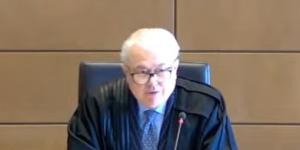In a rigorously structured,exhaustively documented judgment delivered on Monday,Lee has ensured that the hard-partying,until-now cocksure Lehrmann will forever be branded a rapist,based on the civil test of the judge being so persuaded on the balance of probabilities (a lower threshold than would have applied in a criminal trial).

Lisa Wilkinson and Bruce Lehrmann on Monday;Brittany Higgins back in December last year.Getty Images,Dominic Lorrimer,Steven Siewert
But in other respects,there is little comfort for key players Lisa Wilkinson,her producer Angus Llewellyn,Network Ten lawyer Tasha Smithies,and Brittany Higgins herself,despite the stunning vindication the latter has now had on the rape allegation.
Lehrmann has been branded a liar in multiple respects,his overarching need,according to Lee,having been to “fashion his responses in what he perceived to be his forensic interests”.
“To remark that Mr Lehrmann was a poor witness is an exercise in understatement” the judge observed in one of his many cutting bon mots.
But he has branded Higgins,too,an “unreliable historian … a complex and in several respects unsatisfactory witness”.
And while he endorsed her core allegation she was raped on the couch of her then employer Senator Linda Reynolds in the early hours of March 23,2019,he roundly rejected what might be characterised as the second leg of her claims.

That is her insistence,first publicly aired in the bombshell interview with then Ten star presenter Wilkinson in February 2021,that she was the cowed victim of senior political staffers and ministers who callously forced her to choose between the pursuit of justice and her job – a “cover-up” narrative,as Lee puts it,he has now comprehensively debunked.
It was the narrative for which she was “feted” (Lee says) at the fervent height of the #MeToo movement in 2021,yet it was notable,he concluded,for “its inconsistency with the contemporaneous records and its falsities,particularly as to Ms Higgins’ dealings with[Reynolds’ then chief of staff] Ms[Fiona] Brown”.
Lee said he “unhesitatingly” preferred Brown’s evidence to that of Lehrmann and Higgins where their accounts conflicted.
The judge was openly sceptical about a photo of a bruise on Higgins’ leg,which she provided to Ten’s theProject team in January 2021,prior to which there was no metadata evidence that it had existed. Nor did she emerge well from her various explanations as to why police were able to glean some items but not other photos and texts from her phone,when she finally handed it over to them.

Lee found that,“It is more likely than not that she curated data because she thought deleting some material assisted in her maintaining the cogency” of her 2021 cover-up claims.
Higgins’ partner,David Sharaz,who never gave evidence in the case but whose absence from the witness list was pointedly noted a number of times by Lee,has not emerged well either.

Justice Michael Lee delivering his judgment in court one of the Federal Court in Sydney on Monday.Supplied
Sharaz and Higgins,Lee found,made plans to “use the allegations for immediate political advantage” (a reference to the efforts the pair discussed to engage prominent Labor MPs in generating momentum for the cover-up narrative.)
Ten,too,carries scars now from the hard-fought case. It has successfully defended itself on the central allegation it put to air that Higgins was raped.
Yet its senior litigation counsel Tasha Smithies has been handed a caning by Lee for having approved a speech that Wilkinson gave to the Logies awards ceremony,celebrating a win for the Higgins interview,just days before Lehrmann’s (later aborted) criminal trial was due to begin.
The lead producer on the program,Angus Llewellyn,was labelled “often non-responsive” in the witness box and both Llewellyn and Wilkinson were lambasted by Lee for failing to exercise “disinterested professional scepticism” about Higgins’ claims of being politically muzzled in the days,and weeks,after the rape.
What persuaded Lee in the end that the rape had occurred? The first reason was the hours of CCTV footage,audio,texts and other contemporaneous material which he describes himself as “trudging” through “unyieldingly” in his determination to get to the core truth of the case.
The second was his decision to go back to the things Higgins and Lehrmann had said to people in the days immediately after the assault. And the picture that emerged from that was ultimately a simple one.
The pair had been drinking together for hours. Lehrmann was attracted to her. They had kissed passionately at a Canberra club,88 mph,before she and Lehrmann caught an Uber back to Parliament House in the early hours. Lehrmann didn’t go back to work on question time folders,as he ludicrously claimed,but to drink whisky – exactly as Lehrmann had initially described to his then boss Brown three days later.
Perhaps Higgins drank whisky as well,perhaps not. It didn’t matter because Lee found she was already seriously inebriated. She woke to find Lehrmann on top of her,“hell bent” on having sex with her regardless of whether she was in a position to consent or not – which,Lee found,she was not.
Neither of these young people (Higgins was 24 and Lehrmann was 23 on that fateful night) could have imagined in their worst nightmares that their decision to go back to their workplace together after a night of heavy drinking would overshadow the rest of their lives. But this is the result:Lehrmann humiliated,and Higgins vindicated,but bruised.
It is doubtful,now,what will become of the book for which she had received a lucrative contract. Justice Lee observed that the inconsistencies between the draft manuscript and parts of her evidence were not of real significance to him. But he observed,drily,that “autobiography usually reveals nothing bad about its writer except his memory”.
Start the day with a summary of the day’s most important and interesting stories,analysis and insights..